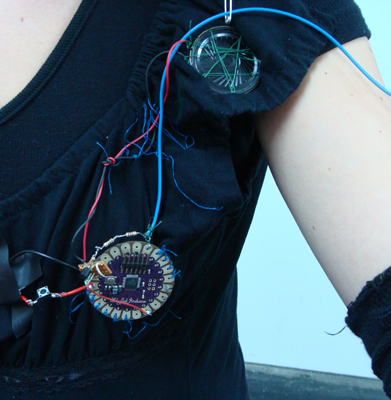Hertzspiegel
The Hertzspiegel mirrows high frequencies of electromagnetic radiation as sonic waves.
The piece consists of an antenna, a dataprocessing unit and a speaker. Conductive wires are used as an antenna; it can be extended or used in a short form to change the reception results. The antenna delivers an analog input to a Lilypad, which varies with the amount of electromagnetic radiation it is exposed to. The Lilypad processes the signal using a code based on Aaron ALAI's EM Detector and outputs the results as an audio coming out of a speaker.
The first version of Herzspiegel is a prototype. For reasons of testing its usability it was directly sewn on a blouse, and the attachable/detachable antenna is sewn on a separate sleeve. By moving around and changing the position of the antenna it is possible to hear via audio the immediate changes in the electromagentic field surrounding us.
The industrial designer and artist Anthony Dunne used the notion 'Hertzian Space'* to define this space, which is real but appears invisible to us. The Hertzian Space is created and strongly modified by human activity. Each electronic device contributes to this space. The Hertzspiegel is an attempt to create a sensorium for this space.
Wireless technologies as we use in our daily lives are kind of 'black boxes' for majority of the users. They are industrial products which offer services defined by the industry. The piece Hertzspiegel tries to bring some light into these mystical objects that surrounds us.
* compare: Anthony Dunne "Hertzian Tales" - Electronic Products, Aesthetic Experience, and Critical Design; The MIT Press 2005

